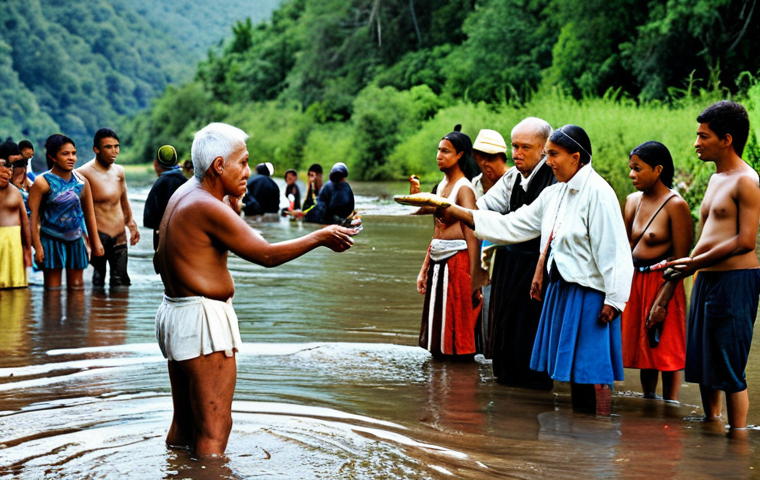The intersection of spirituality and nature has always fascinated me. It’s like, think about it – indigenous cultures worldwide have deeply intertwined their spiritual beliefs with the natural world for centuries.
From sacred groves to animal totems, the environment isn’t just a backdrop; it’s an active participant in their faith. Now, with growing environmental concerns, a fascinating trend is emerging: a renewed interest in animism and earth-based spiritual practices, not just among traditional communities but also in modern spiritual seekers looking for a deeper connection with the planet.
Some futurists even predict a rise in eco-spirituality, where environmental activism and spiritual practices become increasingly integrated. It’s a wild thought, but it makes you wonder if this ancient wisdom holds the key to a more sustainable future.
It’s like rediscovering a lost language, the language of the Earth. Let’s dive deeper into this fascinating topic below.
Alright, let’s dive into this!
Reconnecting with the Earth: Why Ancient Beliefs Matter Now

Modern life often feels detached from nature, right? We’re all about screens, concrete, and processed everything. But think about this: our ancestors lived intimately with the land.
Their survival depended on understanding and respecting the natural world. Animistic beliefs, where spirits inhabit natural objects and phenomena, weren’t just quaint superstitions; they were practical frameworks for living in harmony with the environment.
I’ve been reading about how these beliefs shaped sustainable practices, from rotational farming to seasonal harvesting. It’s not about romanticizing the past, but recognizing the wisdom embedded in these traditions.
I personally felt a shift when I started spending more time in nature, really observing the details – the way sunlight filters through leaves, the sound of wind in the trees.
It’s like waking up a dormant sense, a connection to something larger than myself.
Rediscovering Indigenous Wisdom
1. Indigenous cultures across the globe hold invaluable knowledge about sustainable living and environmental stewardship. 2.
Their spiritual practices often emphasize reciprocity with nature, viewing humans as part of a larger ecosystem rather than separate from it. 3. Learning from these cultures can provide insights into alternative ways of relating to the environment, fostering a deeper sense of responsibility and respect.
The Modern Appeal of Animism
1. For many modern spiritual seekers, animism offers a refreshing alternative to traditional religions that may feel disconnected from the natural world.
2. It provides a framework for experiencing the sacred in everyday life, recognizing the inherent worth and sentience of all living things. 3.
This approach resonates with a growing awareness of environmental issues and a desire to reconnect with the earth on a personal and spiritual level.
Eco-Anxiety and the Search for Meaning
Eco-anxiety is real, y’all. That gnawing feeling of dread about climate change and environmental destruction? I’ve definitely felt it, especially after watching documentaries about deforestation or ocean pollution.
It’s easy to feel overwhelmed and helpless. But here’s the thing: spirituality can offer a powerful antidote. Earth-based practices, like forest bathing or mindful gardening, can ground us in the present moment and remind us of the beauty and resilience of nature.
I started a small vegetable garden last year, and honestly, just getting my hands dirty in the soil has been incredibly therapeutic. Watching those tiny seeds sprout into life, despite all the doom and gloom in the news, gives me a sense of hope and purpose.
Finding Solace in Nature
1. Engaging in nature-based activities can help alleviate eco-anxiety by fostering a sense of connection and belonging. 2.
Mindful practices, such as meditation in nature or nature journaling, can promote emotional well-being and resilience in the face of environmental challenges.
3. By immersing ourselves in the natural world, we can tap into a source of inspiration and strength, reminding us of our inherent connection to the planet.
Spiritual Activism: A Path Forward
1. For many, eco-anxiety can be a catalyst for action, inspiring them to become involved in environmental activism and advocacy. 2.
Spiritual practices can provide a moral compass and a sense of purpose in the fight for environmental justice. 3. By integrating their spiritual values with their activism, individuals can create a more meaningful and impactful contribution to the cause.
The Role of Ritual and Ceremony in Environmentalism
Think about it: humans have always used rituals and ceremonies to mark important transitions and connect with the divine. Why not apply that to our relationship with the environment?
I went to a local river cleanup last year that started with a water blessing ceremony led by a local indigenous elder. It wasn’t just about picking up trash; it was about honoring the river as a living entity and reaffirming our commitment to protecting it.
These kinds of rituals can be powerful tools for raising awareness, fostering community, and inspiring action.
Creating Meaningful Connections
1. Rituals and ceremonies can help us cultivate a deeper sense of connection with the natural world, fostering a sense of reverence and respect. 2.
They can provide a framework for expressing gratitude for the gifts of nature and acknowledging our interdependence with all living things. 3. By engaging in these practices, we can create a more meaningful and personal relationship with the environment.
Community Building and Collective Action
1. Environmental rituals and ceremonies can bring people together, fostering a sense of community and shared purpose. 2.
They can provide a platform for celebrating environmental achievements, honoring environmental heroes, and raising awareness about pressing issues. 3.
By creating spaces for collective action, these practices can empower individuals to make a difference in their communities and beyond.
Sacred Spaces: Protecting Nature’s Cathedrals
Have you ever been to a place that just felt…sacred? Maybe it was a towering redwood forest, a pristine mountain lake, or a secluded desert canyon. These places hold a certain energy, a sense of awe and wonder that transcends the ordinary.
Many cultures recognize certain natural sites as sacred, deserving of protection and reverence. I recently visited a Native American sacred site that was threatened by a proposed mining operation.
The fight to protect that site wasn’t just about preserving biodiversity; it was about safeguarding a cultural heritage and honoring the spiritual connection between people and place.
Defining Sacred Natural Sites
1. Sacred natural sites are places that hold spiritual, cultural, or historical significance for particular communities or groups. 2.
They often possess unique ecological features, such as ancient forests, pristine waterways, or rare species habitats. 3. Protecting these sites is essential for preserving both cultural heritage and biodiversity.
Balancing Conservation and Development
1. The protection of sacred natural sites often involves navigating complex challenges, such as balancing conservation goals with economic development pressures.
2. Collaborative approaches, involving local communities, government agencies, and conservation organizations, are essential for finding sustainable solutions.
3. By recognizing the intrinsic value of these sites, we can work towards a future where both nature and culture thrive.
Animism in the Age of Technology
Okay, this might sound a little out there, but hear me out. Can animism and technology coexist? I think so!
I’ve seen artists using AI to create interactive installations that explore the interconnectedness of all things, blurring the lines between the digital and the natural.
And what about citizen science projects that use smartphones to track wildlife populations or monitor air quality? These tools can actually deepen our understanding and appreciation of the natural world, if we use them mindfully.
It’s about finding ways to integrate technology into our spiritual practice, rather than letting it distract us from it.
Digital Animism: A New Frontier
1. Digital technologies can be used to create immersive experiences that connect individuals with the natural world. 2.
Virtual reality and augmented reality can transport users to remote locations, allowing them to experience the beauty and wonder of nature from the comfort of their own homes.
3. By harnessing the power of technology, we can create new ways of fostering a sense of connection and respect for the environment.
The Ethics of Artificial Intelligence
1. As AI becomes increasingly sophisticated, it is important to consider the ethical implications of its use in relation to the natural world. 2.
We must ensure that AI is used to promote environmental sustainability and protect biodiversity, rather than exacerbating existing problems. 3. By engaging in thoughtful dialogue and developing ethical guidelines, we can harness the potential of AI to create a more just and sustainable future for all.
Practical Steps to Embrace Eco-Spirituality
Alright, so you’re intrigued by all this eco-spirituality stuff, but where do you start? I’d say, begin small. Spend more time in nature, even if it’s just a local park.
Start a gratitude practice, focusing on the gifts of the earth – the air we breathe, the water we drink, the food we eat. Reduce your consumption and waste.
Support local and sustainable businesses. And most importantly, connect with others who share your values. I joined a local environmental group, and it’s been amazing to learn from others and work together on projects that make a difference.
Daily Practices for Connection
1. Spend time in nature regularly, even if it’s just a few minutes each day. 2.
Practice gratitude for the gifts of the earth, acknowledging your dependence on the natural world. 3. Reduce your consumption and waste, making conscious choices that minimize your environmental impact.
Community Engagement and Activism
1. Join a local environmental group or organization, connecting with others who share your values. 2.
Participate in environmental activism and advocacy, supporting policies that protect the environment. 3. By working together, we can create a more sustainable and just world for all.
Here’s a table summarizing some of the concepts we’ve discussed:
| Concept | Description | Example |
|---|---|---|
| Animism | Belief that spirits inhabit natural objects and phenomena | Honoring the spirit of a river through a water blessing ceremony |
| Eco-Anxiety | Distress and worry about environmental problems | Finding solace in nature through forest bathing or mindful gardening |
| Sacred Natural Sites | Places that hold spiritual or cultural significance | Protecting an ancient forest from logging |
| Eco-Spirituality | Integrating spiritual practices with environmental activism | Participating in a river cleanup with a water blessing ceremony |
Okay, here we go!
Wrapping Up
So, let’s bring it all together. Reconnecting with the Earth isn’t just a trend; it’s a necessity. It’s about rediscovering ancient wisdom, finding solace in nature, and integrating spirituality into our daily lives. By embracing eco-spirituality, we can cultivate a deeper sense of connection with the planet and become more effective stewards of the environment. It all starts with small steps, but together, we can make a big difference.
Good to Know
1. Explore local parks and nature reserves in your area. You might be surprised at the hidden gems you discover.
2. Start a compost bin to reduce food waste and enrich your garden soil. It’s a simple way to give back to the earth.
3. Attend local environmental events and workshops to learn more about sustainable living practices.
4. Support businesses that prioritize environmental responsibility and ethical sourcing. Your dollars can make a difference.
5. Consider volunteering for a local environmental organization. It’s a great way to connect with like-minded people and make a positive impact.
Key Takeaways
Animistic beliefs emphasize the interconnectedness of all living things, fostering a sense of respect and responsibility towards the environment.
Eco-anxiety can be alleviated through nature-based practices and spiritual activism, empowering individuals to take action and create positive change.
Rituals and ceremonies can help us cultivate a deeper connection with the natural world, fostering a sense of reverence and gratitude.
Sacred natural sites hold spiritual and cultural significance, deserving of protection and conservation for future generations.
Technology can be used to enhance our connection with nature, but it’s important to consider the ethical implications and use it mindfully.
Frequently Asked Questions (FAQ) 📖
Q: What exactly is animism, and how does it relate to modern spirituality?
A: Okay, so animism, at its core, is the belief that all things – plants, animals, even rocks and rivers – have a spirit or soul. It’s way more than just seeing pretty scenery; it’s about recognizing that everything is interconnected and has its own intrinsic value.
Now, in modern spirituality, you see a lot of folks drawing on animistic principles to deepen their connection with nature. Think of it like this: instead of just hiking through the woods, you’re acknowledging the forest’s spirit, maybe even having a silent conversation with the trees.
It’s about moving beyond a purely transactional view of nature to one of reciprocal respect and understanding. Personally, when I started approaching nature this way, it totally changed my perspective – I felt a sense of belonging I hadn’t experienced before.
Q: You mentioned eco-spirituality. How is that different from traditional environmentalism?
A: That’s a great question! Traditional environmentalism often focuses on scientific data, policy changes, and activism to protect the environment, which is obviously super important.
Eco-spirituality, on the other hand, adds a spiritual dimension to this. It’s about seeing the Earth not just as a resource to be managed, but as a sacred entity worthy of reverence and care.
I remember reading about a community garden in Brooklyn that incorporated meditation and earth-based rituals into their work. They found that it not only boosted morale but also deepened their commitment to sustainable practices.
It’s like, environmentalism aims to protect the planet, while eco-spirituality aims to heal our relationship with it.
Q: What are some practical ways someone can explore eco-spirituality in their daily life, even if they live in a city?
A: Totally doable! You don’t need to move to the countryside to connect with nature spiritually. Even small things can make a huge difference.
For instance, try tending to a houseplant with intention – not just watering it, but actually connecting with its energy and thanking it for the air it provides.
Or, find a local park and practice mindful walking, paying attention to the sights, sounds, and smells of nature around you. Some folks even find solace in urban gardening, growing their own food and connecting with the earth in a tangible way.
I once met a woman in Manhattan who kept a small balcony garden, and she swore it was her spiritual lifeline in the concrete jungle. It’s all about finding those small pockets of nature in your everyday life and treating them with reverence.
The key, I’ve found, is to approach it with a sense of curiosity and openness, and to let your own unique connection with nature unfold naturally.
📚 References
Wikipedia Encyclopedia
구글 검색 결과
구글 검색 결과
구글 검색 결과
구글 검색 결과
구글 검색 결과




